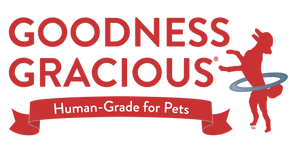Dog Food Defender Against Deception, Says Choose Human Grade

An advocate helps us make informed choices amidst deceptive pet food packaging and lack of guarantees
You pick up a bag of granola in the grocery store snack aisle. You look at the ingredient panel for things like sugar and sodium (the less the better); and things like protein and fiber (high is good); and fat (moderate is acceptable). You don’t even want to think about carbs, but they’re labeled too. You look at the calories (lowish is helpful). Maybe you glance at the micronutrients like iron and calcium and vitamin D because your doc tells you, you need these things.
Now you pick up a bag of pet food. You want to make these same informed choices for your dog. What you get is a bunch of “ish”. Protein – it has maybe-ish 30%. Fat – it has around-ish 15%. Fiber – it has sorta-ish 5%. Moisture? (You think: “Who really cares?”) But that’s on there too in another give-or-take-ish range of 10%. And nothing adds up to 100%.
You think: “Where are the carbs? My vet said to limit the carbs.”
He also said to limit the calories. Where are the calories and what is a KCAL ME/cup and KCAL ME/KG? You think it has something to do with calories… there’s the “CAL” in “KCAL”. But for crying out loud; you now feel stupid; you feel befuddled; you feel you need a calculator, a cheat-sheet, maybe even a superhero.
You throw the bag in your grocery cart because all the bags of pet food are as confounding as the one you’re holding. But this one has pretty pictures of fresh chicken, carrots and broccoli on the label. And BAM: that is precisely what the Big Kibble Companies want you to do.
No one is looking out for you, you think. Then comes Susan to the rescue.
Susan Thixton. Guardian at the gate. Superhero and savior. Advocate for animals everywhere. Founder of TruthAboutPetFood and its association of concerned consumers, explains what that label means, why, and what you can do about it.
Misleading Ingredients and Those Pretty Pictures
For starters, the pretty pictures mean nothing. In fact on most mass-produced bags of pet food and dog treats, the images are deceptive. Thixton warns that although regulations prohibit misleading images this prohibition is never enforced. It is best to ignore images on pet food labels.
According Thixton, the ingredients used in these products have very specific legal definitions that are often quite different from what we understand them to be for our own human-grade food. While the label provides a list of ingredients, we are not provided with the legal definitions of those ingredients. They are owned by AAFCO and protected by copyright. Every consumer needs to pay AAFCO $200 for that information.
For example, Thixton says, many pet food labels tout “Made with Real Chicken” or “Chicken Is the 1st Ingredient.” This can legally mean it’s made with animal feed-grade chicken, which is not the same type of chicken you eat. Pet food regulations define “chicken” as either human edible chicken (i.e. USDA inspected and passed), or inedible chicken (i.e. USDA inspected and condemned). The label does not tell us which type of chicken is in the food; either is acceptable.
Three Cheers for Human Grade Pet Foods!
“The most meaningful words found on a pet food label are ‘human grade,’” says Thixton. “Regulatory authorities consider most pet foods to be ‘feed grade.’ This is how condemned meats and other material end up in pet food: they are ‘feed,’ not ‘food.’ But when we see ‘human grade’ on the label, we can be sure that every ingredient (including supplements) is edible by humans. Further, it provides assurance that the pet food was manufactured according to food-safety laws, which feed grade pet foods are not required to do.”
Thixton also tells consumers to “be aware that many pet food manufacturers make a ‘human grade’ ingredients claim on their websites, but that claim may or may not be true; regulatory authorities do not scrutinize these sites. So, while we can trust the claim on the human grade label, we should be skeptical about it on a website.”
Here at Goodness Gracious, we love Susan Thixton
Goodness Gracious makes human grade treats for dogs, like our Hula Lula single ingredient chicken jerky for dogs. We use only USDA inspected and passed ingredients in our own licensed and inspected human food facility following current Good Manufacturing Practices. As Mom to my pack of three pups, I started Goodness Gracious 11 years ago because of the alarming industry practices that Susan Thixton defends us against.
I am a consumer of USA made, USA sourced pet food, though I usually feed my own high protein, whole food, grain free, species appropriate, homemade dog food following a formula given to me by my veterinarian. It is a nutritious, healthy diet for dogs.
I personally am a member of the Association for Truth in Pet Food which enables Ms. Thixton to advocate for pet parents and their packs everywhere. She confronts FDA. She stands up to Big Kibble Companies. She takes our charge to AAFCO. I highly recommend you join the association or at least sign up for the TruthAboutPetFood newsletter.
Here's to making informed choices for our beloved babies. May they live to be 100.


